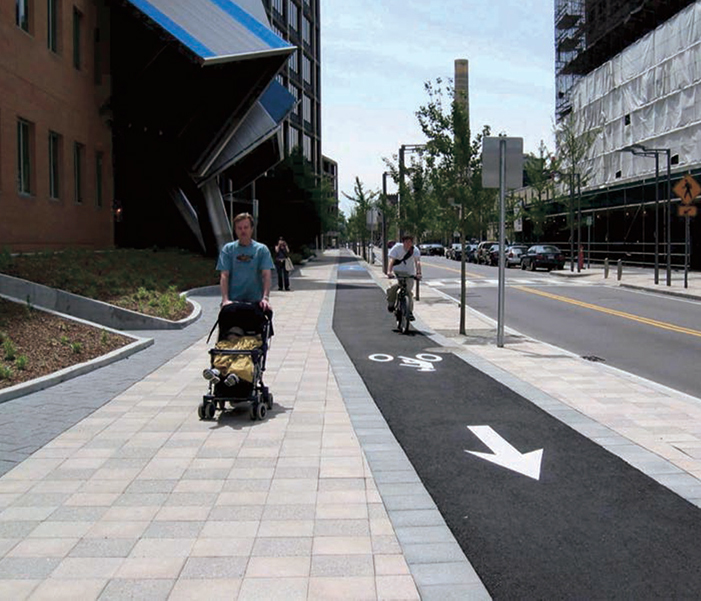
Raised Cycle Tracks

CAMBRIDGE, MA
Raised cycle tracks are bicycle facilities that are vertically separated from motor vehicle traffic. Many are paired with a furnishing zone between the cycle track and motor vehicle travel lane and/or pedestrian area. A raised cycle track may allow for one-way or two-way travel by bicyclists. Two-way cycle tracks have some different operational characteristics that merit additional consideration.
Raised cycle tracks may be at the level of the adjacent sidewalk, or set at an intermediate level between the road- way and sidewalk to segregate the cycle track from the pedestrian area. A raised cycle track may be combined with a parking lane or other barrier between the cycle track and the motor vehicle travel lane (refer to protected cycle tracks for additional guidance). At intersections, the raised cycle track can be dropped and merged onto the street (see Cycle Track Intersection Approach), or it can be maintained at side-walk level, where bicyclists cross with pedestrians, possibly with a dedicated bicycle signal.

HILLSBORO, OR (PHOTO: WILL VANLUE)
When placed adjacent to a travel lane, one-way raised cycle tracks may be configured with a mountable curb to allow entry and exit from the bicycle lane for passing other bicyclists or to access vehicular turn lanes. This configuration has also been known as a ‘raised bike lane.’
Benefits
Dedicates and protects space for bicyclists in order to improve perceived comfort and safety.29
More attractive to a wider range of bicyclists at all levels and ages than less separated facilities.
Keeps motorists from easily entering the cycle track.
Encourages bicyclists to ride in the bikeway rather than on the sidewalk.
Can visually reduce the width of the street when provided adjacent to a travel lane.30
Minimizes maintenance costs due to limited motor vehicle wear.
With new roadway construction a raised cycle track can be less expensive to construct than a wide or buffered bicycle lane.

PORTLAND, OR
Typical Applications
Raised cycle tracks can be considered wherever a bicycle lane would be the standard recommendation. They may be most beneficial:
• Along higher speed streets with few driveways and cross streets.
• Along streets on which bike lanes would cause many bicyclists to feel stress because of factors such as multiple lanes, high traffic volumes, high speed traffic, high demand for double parking, and high parking turnover.
• On streets for which conflicts at intersections can be effectively mitigated using parking lane setbacks, bicycle markings through the intersection, and other signalized intersection treatments.
• On streets with numerous curves where vehicle encroachment into bike lanes may be a concern.
• Along streets with high bicycle volumes.
Special consideration should be given at transit stops to manage bicycle and pedestrian interactions. See Cycle Track Intersection Approach for transitioning strategies.
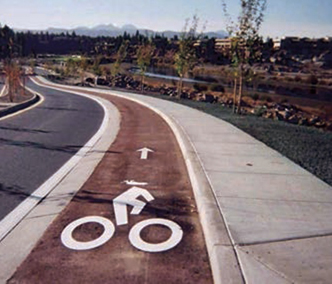
BEND, OR
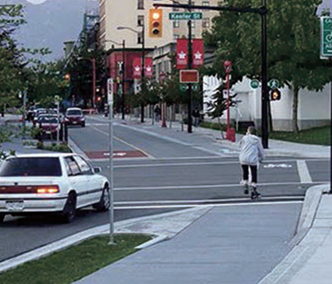
VANCOUVER, BC (PHOTO: WWW. PEDBIKEIMAGES.ORG, CARL SUNDSTROM)
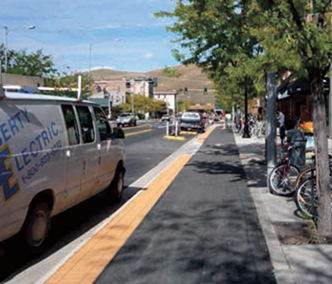
MISSOULA, MT

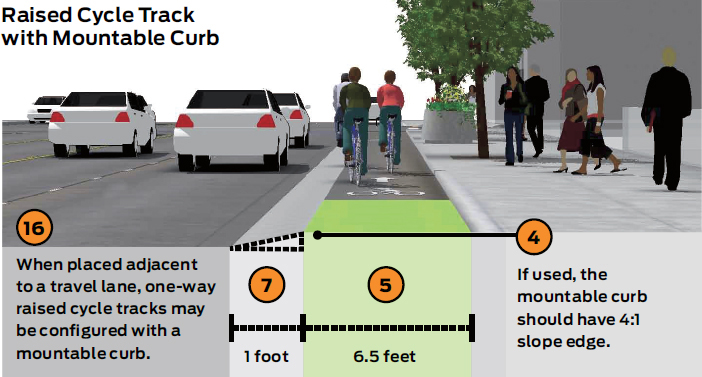
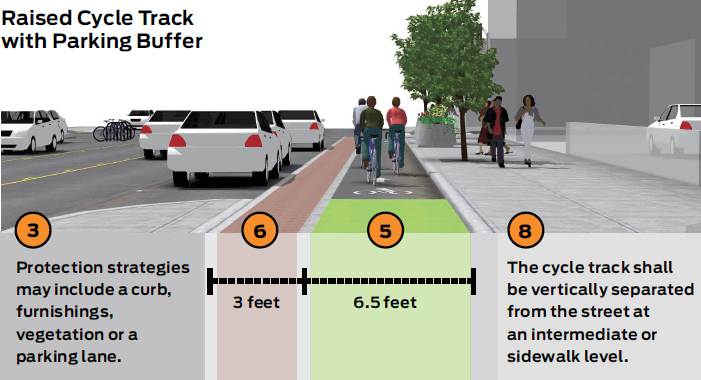
Required Features
 The cycle track shall be vertically separated from the street at an intermediate or sidewalk level.
The cycle track shall be vertically separated from the street at an intermediate or sidewalk level.
 Bicycle lane word, symbol, and/ or arrow markings (MUTCD Figure 9C-3) shall be placed at the beginning of a cycle track and at periodic intervals along the facility based on engineering judgment.
Bicycle lane word, symbol, and/ or arrow markings (MUTCD Figure 9C-3) shall be placed at the beginning of a cycle track and at periodic intervals along the facility based on engineering judgment.
 A raised cycle track shall be protected from the adjacent motor vehicle travel lane. Protection strategies may include a raised or mountable curb, street furnishings, low vegetation or a parking lane.
A raised cycle track shall be protected from the adjacent motor vehicle travel lane. Protection strategies may include a raised or mountable curb, street furnishings, low vegetation or a parking lane.
 If used, the mountable curb should have 4:1 slope edge without any seams or lips to interfere with bike tires to allow for safe entry and exit of the roadway. This curb should not be considered a ridable surface when determining cycle track width.31
If used, the mountable curb should have 4:1 slope edge without any seams or lips to interfere with bike tires to allow for safe entry and exit of the roadway. This curb should not be considered a ridable surface when determining cycle track width.31
Recommended Features
 Desirable one-way raised cycle track travel surface width is 6.5 feet to allow side-by-side riding or passing. Desired minimum width is 5 feet at intersections and pinch points. Additional width may be needed for protection from traffic or parking and/or shy distance to sidewalks or furnishings.32
Desirable one-way raised cycle track travel surface width is 6.5 feet to allow side-by-side riding or passing. Desired minimum width is 5 feet at intersections and pinch points. Additional width may be needed for protection from traffic or parking and/or shy distance to sidewalks or furnishings.32
 When configured next to a parking lane, 3 feet is the minimum desired width for a parking buffer to allow for passenger loading and to prevent dooring collisions. The buffer can be at street level or at the level of the cycle track.33
When configured next to a parking lane, 3 feet is the minimum desired width for a parking buffer to allow for passenger loading and to prevent dooring collisions. The buffer can be at street level or at the level of the cycle track.33
 When configured next to a motor vehicle travel lane, the desired minimum width of a mountable curb is 1 foot, depending on elevation. Raised curbs may require additional width for added shy distance from the curb edge. Raised curb buffer minimum width should be increased to 3 feet or greater when buffer space is used to locate lamp posts, bollards, street furniture, low vegetation, and/or trees.34
When configured next to a motor vehicle travel lane, the desired minimum width of a mountable curb is 1 foot, depending on elevation. Raised curbs may require additional width for added shy distance from the curb edge. Raised curb buffer minimum width should be increased to 3 feet or greater when buffer space is used to locate lamp posts, bollards, street furniture, low vegetation, and/or trees.34
 Vertical separation between the roadway and the cycle track should be between 1 and 6 inches. Higher separation values discourage illegal parking.
Vertical separation between the roadway and the cycle track should be between 1 and 6 inches. Higher separation values discourage illegal parking.
 Vertical separation between the cycle track and the sidewalk should be between zero (flush with the sidewalk surface) and 5 inches. A separation of 3 inches or greater discourages conflicts with pedestrians.
Vertical separation between the cycle track and the sidewalk should be between zero (flush with the sidewalk surface) and 5 inches. A separation of 3 inches or greater discourages conflicts with pedestrians.
 If curb or median separated, careful consideration should be given to the curb design. Curbs of 6 inches can be hazards to bicyclists by interfering with the space needed for pedaling, but can be more effective deterrents to illegal parking or loading. Consider the use of alternative bicycle-friendly curb profiles where possible.35
If curb or median separated, careful consideration should be given to the curb design. Curbs of 6 inches can be hazards to bicyclists by interfering with the space needed for pedaling, but can be more effective deterrents to illegal parking or loading. Consider the use of alternative bicycle-friendly curb profiles where possible.35
 Supplemental shy distance striping should be added at the entrance to curb protected cycle tracks to encourage bicyclists to keep their distance.
Supplemental shy distance striping should be added at the entrance to curb protected cycle tracks to encourage bicyclists to keep their distance.
 Driveways and minor street crossings are a unique challenge to cycle track design. A review of existing facilities and design practice has shown that the following guidance may improve safety at crossings of driveways and minor intersections:
Driveways and minor street crossings are a unique challenge to cycle track design. A review of existing facilities and design practice has shown that the following guidance may improve safety at crossings of driveways and minor intersections:
• If the cycle track is parking protected, parking should be prohibited near the intersection to improve visibility. The desirable no-parking area is 30 feet from each side of the crossing.36
• For motor vehicles attempting to cross the cycle track from the side street or driveway, street and sidewalk furnishings and/or other features should accommodate a sight triangle of 20 feet to the cycle track from minor street crossings, and 10 feet from driveway crossings.
• Color, yield lines, and “Yield to Bikes” signage should be used to identify the conflict area and make it clear that the cycle track has priority over entering and exiting traffic.37
• Motor vehicle traffic crossing the cycle track should be constrained or channelized to make turns at sharp angles to reduce travel speed prior to the crossing.
• The crossing should be raised, in which the sidewalk and cycle track maintain their elevation through the crossing. Sharp inclines on either side from road to sidewalk level serve as a speed hump for motor vehicles.38
• If configured at a height flush with the sidewalk, color, pavement markings, textured surfaces, landscaping, or other furnishings should be used to discourage pedestrian use of the cycle zone.

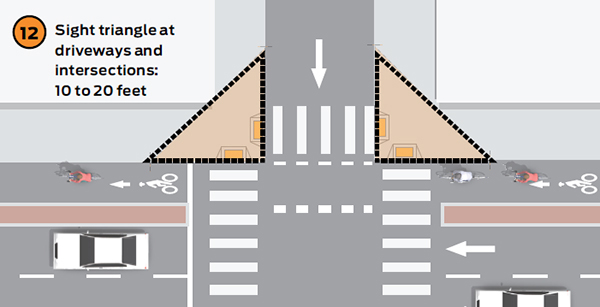
 Drainage should slope to the street. Drainage grates should be in adjacent travel or parking lane.
Drainage should slope to the street. Drainage grates should be in adjacent travel or parking lane.
 Two-stage turn boxes should be provided to assist in making turns from the cycle track facility.
Two-stage turn boxes should be provided to assist in making turns from the cycle track facility.
Optional Features
 Cycle tracks may be shifted more closely to the travel lanes on minor intersection approaches to put bicyclists clearly in the field of view of motorists.39
Cycle tracks may be shifted more closely to the travel lanes on minor intersection approaches to put bicyclists clearly in the field of view of motorists.39
 When placed adjacent to a travel lane, one-way raised cycle tracks may be configured with a mountable curb to allow entry and exit from the bicycle lane for passing other bicyclists or to access vehicular turn lanes. This configuration has also been known as a “raised bike lane.”
When placed adjacent to a travel lane, one-way raised cycle tracks may be configured with a mountable curb to allow entry and exit from the bicycle lane for passing other bicyclists or to access vehicular turn lanes. This configuration has also been known as a “raised bike lane.”
 If the cycle track is not already at sidewalk level, consider raising the cycle track to sidewalk level and wrapping the cycle track around the transit stop zone to reduce conflicts with transit vehicles at midblock or signal protected intersections. Bicyclists should yield to pedestrians in these areas.
If the cycle track is not already at sidewalk level, consider raising the cycle track to sidewalk level and wrapping the cycle track around the transit stop zone to reduce conflicts with transit vehicles at midblock or signal protected intersections. Bicyclists should yield to pedestrians in these areas.
 Contra-flow bike lanes may be raised in a cycle track configuration to offer further physical protection for contra-flow riders.
Contra-flow bike lanes may be raised in a cycle track configuration to offer further physical protection for contra-flow riders.
 Cycle tracks may be configured on the left side of a one-way street to avoid conflicts at transit stops.
Cycle tracks may be configured on the left side of a one-way street to avoid conflicts at transit stops.
 Color may be used to contrast with the adjacent pedestrian area or to increase the visibility of the cycle track in conflict areas.
Color may be used to contrast with the adjacent pedestrian area or to increase the visibility of the cycle track in conflict areas.
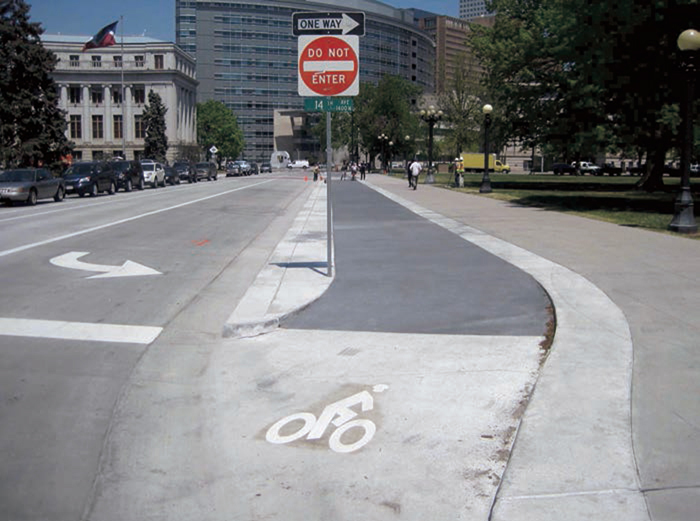
DENVER, CO
Maintenance
Raised cycle tracks should be maintained to be free of pavement damage, broken glass, and other debris.
Raised cycle tracks may be incompatible with conventional street sweeping equipment and snow plow equipment, depending on their configuration. There should be enough shy distance on the adjacent roadway so that snow is not stored on the raised cycle track.
Raised cycle tracks receive less wear and tear than travel lanes.
ADA/PROWAG Considerations
Raised cycle tracks may function better for persons with mobility disabilities than street level cycle tracks. If accessible parking spaces are to be provided adjacent to the raised cycle track, a widened buffer may be provided to accommodate a side mounted ramp or lift that will not protrude into the cycle track and become a hazard to bicyclists. At these locations, the raised cycle track may be flush with the buffer and adjacent sidewalk with street furnishings placed to minimize conflict.
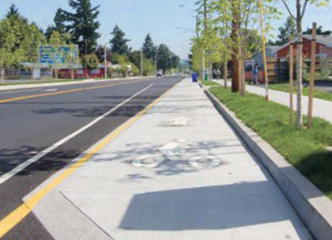
PORTLAND, OR
Treatment Adoption and Professional Consensus
Commonly used in dozens of European bicycle friendly cities.
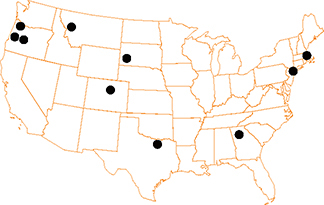
Currently used in the following US cities:
• Atlanta, GA
• Bend, OR
• Cambridge, MA
• Denton, TX
• Denver, CO
• Eugene, OR
• Missoula, MT
• New York, NY
• Portland, OR
• Rapid City, SD